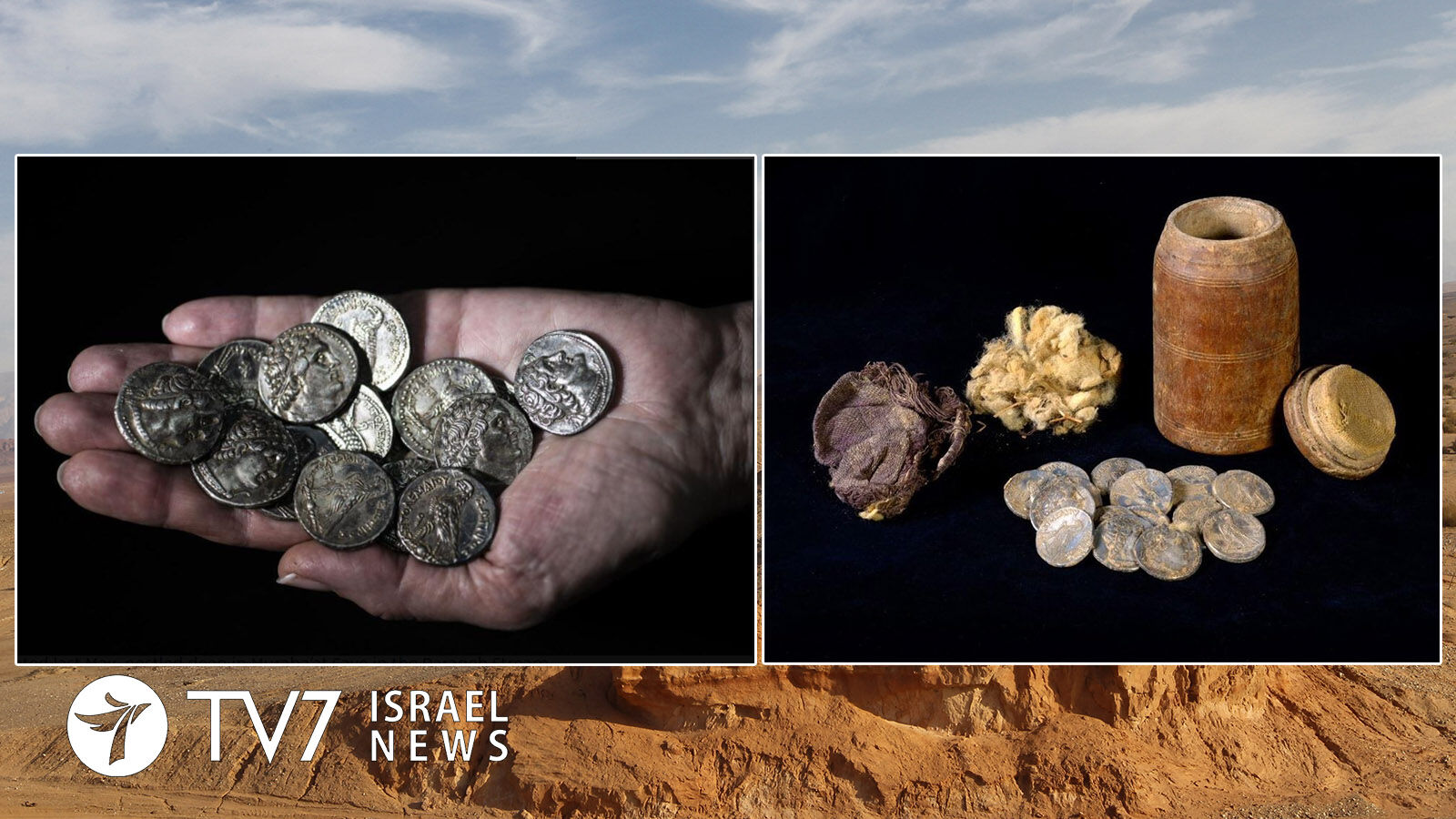A rare wooden container with 15 silver coins dating back to the reign of Antiochos IV was found during excavation at the Darageh Stream Nature Reserve, overlooking the Dead Sea.
By Erin Viner
The find marks the first evidence in the Judean Desert for the Maccabean Revolt against the Greek Seleucid Kingdom, said an Israel Antiquities Authority (IAA) statement, which carried out the excavation in the framework of the Judean Desert Excavation and Survey Project with the Archaeological Office for the Military Administration of Judea and Samaria, in cooperation with the Ministry for Jerusalem and Heritage.
Evidence for a dramatic moment in the history of the Jewish people had been hidden in a crack of the Muraba‘at Cave about 2,200 years ago.
The upper portion of the ancient cylinder was full of packed earth and small stones, below which the tetradrachma silver coins wrapped in a purple woolen cloth.
Archeological researchers believe that they minted by Ptolemy VI, King of Egypt, who reigned at the same time as his uncle Antiochos IV Epiphanes (“the Wicked”) ruled the Seleucid Kingdom, including Judea. The earliest of the coins were found to have been made in 176-175 BC and the latest in 171-170 BC. The latter date adheres to to the start of the Maccabean Revolt and the war declared against Antiochos’ decrees against the Jewish religion.
Hanukah, also known as Chanukah or the Festival of Lights, commemorates the miracle performed by God in the recovery of Jerusalem and subsequent rededication of the Second Temple at the beginning of the Maccabean Revolt against the Seleucid Empire in the 2nd century BC.
“It is interesting to try to visualize the person who fled to the cave and hid his personal property here intending to return to collect it. The person was probably killed in the battles, and he did not return to collect his possessions – that awaited almost 2,200 years until we retrieved it,” said Dr. Eitan Klein, who studied the coins together with IAA numismatic expert Dr. Gabriela Bijovsky.
The Books of the Maccabees describe the dramatic events of the times that would have led people to hide their belongings in the Judean Desert until the danger passed, explained Dr. Klein, particularly due to the plundering of the Jerusalem Temple treasures by Antiochos and the destruction of the Jerusalem city wall in the years that led up to the Hasmonean Revolt.
Another possibility that the money was hidden could be linked to the 167 BC religious decrees imposed that caused Jews to flee to hiding places in the desert. As written in I Maccabees 2:29–37: “Then many who were seeking righteousness and justice went down to the wilderness to dwell there: they, their sons, their wives, and their cattle, because evils pressed heavily upon them. And it was reported to the king’s officers, and to the troops in Jerusalem in the city of David, that men who had rejected the king’s command had gone down to the hiding places in the wilderness. Many pursued them and overtook them; they encamped opposite them and prepared for battle against them on the Sabbath day…. and they died, with their wives and children and cattle, about a thousand persons.”
“This moving find, coming just before the festival of Hanukah, is symbolic, emphasizing once again the importance of our activity in the field of heritage,” Zeev Elkin, Minister of Construction and Housing, Jerusalem and Heritage, which has invested millions of shekels in recent years to save and preserve many heritage sites in the Judean Desert, Judea and Samaria.
“The Survey and Excavation Project carried out by the Israel Antiquities Authority in the Judean Desert over the past six years has proved itself, in that thousands of archaeological artifacts have been saved from destruction and plundering, including parts of biblical scrolls, arrowheads from the Bar Kochba Revolt, a 10,500-year-old basket and more,” added Amir Ganor, who directed the Muraba‘at Cave excavation on behalf of the IAA.
Civil Administration Archaeology Staff Officer Hananya Hizmi vowed that the discovery of the latest treasure represents another step in the extensive activity of his unit’s tireless work “to preserve all the archaeological sites in Judea and Samaria, and we will not cease to look for and excavate historical discoveries such as this.”
The IAA, Israel Ministry of Jerusalem and Heritage and the Civil Administration of Judea and Samaria have invited the public to join the Excavation Project that will take place this month in the Judean Desert. The coins will be exhibited to the public in the Hasmonean Museum in Modi‘in, as part of the “Israel Heritage Week” that will take place during Hanukah, set to start on 18 December.
